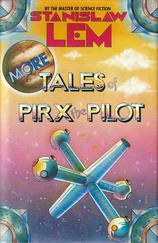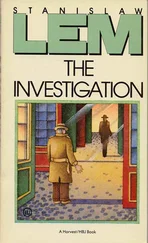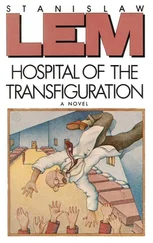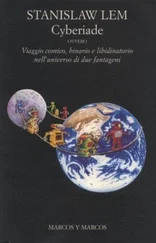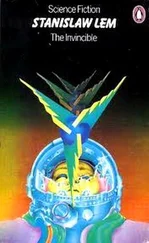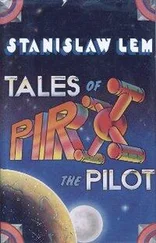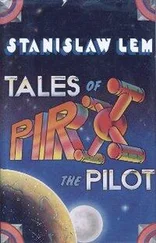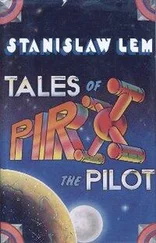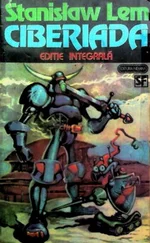Stanislaw Lem - The Cyberiad
Здесь есть возможность читать онлайн «Stanislaw Lem - The Cyberiad» весь текст электронной книги совершенно бесплатно (целиком полную версию без сокращений). В некоторых случаях можно слушать аудио, скачать через торрент в формате fb2 и присутствует краткое содержание. Город: New York, Год выпуска: 1974, Издательство: Continuum Book, Жанр: Фантастика и фэнтези, на английском языке. Описание произведения, (предисловие) а так же отзывы посетителей доступны на портале библиотеки ЛибКат.
- Название:The Cyberiad
- Автор:
- Издательство:Continuum Book
- Жанр:
- Год:1974
- Город:New York
- ISBN:нет данных
- Рейтинг книги:5 / 5. Голосов: 1
-
Избранное:Добавить в избранное
- Отзывы:
-
Ваша оценка:
- 100
- 1
- 2
- 3
- 4
- 5
The Cyberiad: краткое содержание, описание и аннотация
Предлагаем к чтению аннотацию, описание, краткое содержание или предисловие (зависит от того, что написал сам автор книги «The Cyberiad»). Если вы не нашли необходимую информацию о книге — напишите в комментариях, мы постараемся отыскать её.
Trurl and Klaupacius are constructor robots who try to out-invent each other. Over the course of their adventures in
, they travel to the far corners of the cosmos to take on freelance problem-solving jobs, with dire consequences for their unsuspecting employers. Playfully written, and ranging from the prophetic to the surreal, these stories demonstrate Stanislaw Lem’s vast talent and remarkable ability to blend meaning and magic into a wholly entertaining and captivating work.
The Cyberiad — читать онлайн бесплатно полную книгу (весь текст) целиком
Ниже представлен текст книги, разбитый по страницам. Система сохранения места последней прочитанной страницы, позволяет с удобством читать онлайн бесплатно книгу «The Cyberiad», без необходимости каждый раз заново искать на чём Вы остановились. Поставьте закладку, и сможете в любой момент перейти на страницу, на которой закончили чтение.
Интервал:
Закладка:
“And if the King has planted a real constructor among our servants, which is not unlikely, then it’s all over and into the pit with us. Besides, running away—no, it just doesn’t suit me. It’s him or us, Trurl, you can’t get around it.”
“Yes, I suppose a spy could be a constructor too,” said Trurl with a sigh. “What then can we do, in the name of the Great Comet?! How about—a photoelectric phantom?”
“You mean, a mirage? Have the King hunt a mirage? No thanks! After an hour or two of that, he’d come straight here and make phantoms of us!”
Again they were silent. Finally Trurl said:
“The only way out of our difficulty, as far as I can see, is to have the beast abduct the King, and then—”
“You don’t have to say another word. Yes, that’s not at all a bad idea… Then for the ransom we—and haven’t you noticed, old boy, that the orioles here are a deeper orange than on Maryland IV?” concluded Klapaucius, for just then some servants were bringing silver lamps out on the veranda. “There’s still a problem though,” he continued when they were alone again. “Assuming the beast can do what you say, how will we be able to negotiate with the prisoner if we’re sitting in a dungeon ourselves?”
“You have a point there,” said Trurl. “We’ll have to figure some way around that… The main thing, however, is the algorithm!”
“Any child knows that! What’s a beast without an algorithm?”
So they rolled up their sleeves and sat down to experiment—by simulation, that is mathematically and all on paper. And the mathematical models of King Krool and the beast did such fierce battle across the equation-covered table, that the constructors’ pencils kept snapping. Furious, the beast writhed and wriggled its iterated integrals beneath the King’s polynomial blows, collapsed into an infinite series of indeterminate terms, then got back up by raising itself to the n th power, but the King so belabored it with differentials and partial derivatives that its Fourier coefficients all canceled out (see Riemann’s Lemma), and in the ensuing confusion the constructors completely lost sight of both King and beast. So they took a break, stretched their legs, had a swig from the Leyden jug to bolster their strength, then went back to work and tried it again from the beginning, this time unleashing their entire arsenal of tensor matrices and grand canonical ensembles, attacking the problem with such fervor that the very paper began to smoke. The King rushed forward with all his cruel coordinates and mean values, stumbled into a dark forest of roots and logarithms, had to backtrack, then encountered the beast on a field of irrational numbers (F 1) and smote it so grievously that it fell two decimal places and lost an epsilon, but the beast slid around an asymptote and hid in an n -dimensional orthogonal phase space, underwent expansion and came out, fuming factorially, and fell upon the King and hurt him passing sore. But the King, nothing daunted, put on his Markov chain mail and all his impervious parameters, took his increment Δ k to infinity and dealt the beast a truly Boolean blow, sent it reeling through an x-axis and several brackets—but the beast, prepared for this, lowered its horns and—wham!!—the pencils flew like mad through transcendental functions and double eigentransformations, and when at last the beast closed in and the King was down and out for the count, the constructors jumped up, danced a jig, laughed and sang as they tore all their papers to shreds, much to the amazement of the spies perched in the chandelier-—perched in vain, for they were uninitiated into the niceties of higher mathematics and consequently had no idea why Trurl and Klapaucius were now shouting, over and over, “Hurrah! Victory!!”
Well after midnight, the Leyden jug from which the constructors had on occasion refreshed themselves in the course of their labors was quietly taken to the headquarters of the King’s secret police, where its false bottom was opened and a tiny tape recorder removed. This the experts switched on and listened to eagerly, but the rising sun found them totally unenlightened and looking haggard. One voice, for example, would say:
“Well? Is the King ready?”
“Right!”
“Where’d you put him? Over there? Good! Now—hold on, you have to keep the feet together. Not yours, idiot, the King’s! All right now, ready? One, two, find the derivative! Quick! What do you get?”
“Pi.”
“And the beast?”
“Under the radical sign. But look, the King’s still standing!”
“Still standing, eh? Factor both sides, divide by two, throw in a few imaginary numbers—good! Now change variables and subtract—Trurl, what on earth are you doing?! The beast , not the King, the beast ! That’s right! Good! Perfect!! Now transform, approximate and solve for x . Do you have it?”
“I have it! Klapaucius! Look at the King now!!”
There was a pause, then a burst of wild laughter.
That same morning, as all the experts and high officials of the secret police shook their heads, bleary-eyed after a sleepless night, the constructors asked for quartz, vanadium, steel, copper, platinum, rhinestones, dysprosium, yttrium and thulium, also cerium and germanium, and most of the other elements that make up the Universe, plus a variety of machines and qualified technicians, not to mention a wide assortment of spies—for so insolent had the constructors become, that on the triplicate requisition form they boldly wrote: “Also, kindly send agents of various cuts and stripes at the discretion and with the approval of the Proper Authorities.” The next day they asked for sawdust and a large red velvet curtain on a stand, a cluster of little glass bells in the center and a large tassel at each of its four corners; everything, even down to the littlest glass bell, was specified with the utmost precision. The King scowled when he heard these requests, but ordered them to be carried out to the letter, for he had given his royal word. The constructors were thus granted all that they wished.
All that they wished grew more and more outlandish. For instance, in the files of the secret police under code number 48999/11K/T was a copy of a requisition for three tailor’s mannequins as well as six full police uniforms, complete with sash, side arm, shako, plume and handcuffs, also all available back issues of the magazine The Patriotic Policeman , yearbooks and supplements included—under “Comments” the constructors had guaranteed the return of all items listed above within twenty-four hours of delivery and in perfect condition. In another, classified section of the police archives was a copy of a letter from Klapaucius in which he demanded the immediate shipment of (1) a life-size doll representing the Postmaster General in full regalia, and (2) a light gig painted green with a kerosene lamp on the left and a sky-blue sign on the back that said THINK. The doll and gig proved too much for the Chief of Police: he had to be taken away for a much-needed rest. During the next three days the constructors asked only for barrels of red castor oil, and after that—nothing. From then on, they worked in the basement of the palace, hammering away and singing space chanties, and at night blue lights came flashing from the basement windows and gave weird shapes to the trees in the garden outside. Trurl and Klapaucius with their many helpers bustled about amid arcs and sparks, now and then looking up to see faces pressed against the glass: the servants, as if out of idle curiosity, were photographing their every move. One evening, when the weary constructors had finally dragged themselves off to bed, the components of the apparatus they had been working on were quickly transported by unmarked balloon to police headquarters and assembled by eighteen of the finest cyberneticians in the land, who had been deputized and duly sworn in for that very purpose, whereupon a gray tin mouse ran out from under their hands, blowing soap bubbles and dropping a thin trail of chalk dust from under its tail, which spelled, as it danced this way and that across the table, WHAT, DON’T YOU LOVE US ANYMORE? Never before in the kingdom’s history did Chiefs of Police have to be replaced with such speed and regularity. The uniforms, the doll, the green gig, even the sawdust, everything which the constructors returned exactly as promised, was thoroughly examined under electron microscope. But except for a minuscule card in the sawdust which read JUST SAWDUST, there was nothing out of the ordinary. Then individual atoms of the uniforms and gig were thoroughly searched— with equal lack of success. At last the day came when the work was completed. A huge vehicle on three hundred wheels, looking something like a refrigerator, was drawn up to the main entrance and opened in the presence of witnesses and officials; Trurl and Klapaucius brought out a curtain, the one with the tassels and bells, and placed it carefully inside, in the middle of the floor. Then they got in themselves, closed the door, did something, then went and got various containers from the basement, cans of chemicals, all sorts of finely ground powders—gray, silver, white, yellow, green—and sprinkled them under and around the curtain, then stepped out, had the vehicle closed and locked, consulted their watches and together counted out fourteen and a half seconds—at which time, much to everyone’s surprise, since the vehicle was stationary and there could be no question of a breeze inside (for the seal was hermetic), the glass bells tinkled. The constructors exchanged a wink and said:
Читать дальшеИнтервал:
Закладка:
Похожие книги на «The Cyberiad»
Представляем Вашему вниманию похожие книги на «The Cyberiad» списком для выбора. Мы отобрали схожую по названию и смыслу литературу в надежде предоставить читателям больше вариантов отыскать новые, интересные, ещё непрочитанные произведения.
Обсуждение, отзывы о книге «The Cyberiad» и просто собственные мнения читателей. Оставьте ваши комментарии, напишите, что Вы думаете о произведении, его смысле или главных героях. Укажите что конкретно понравилось, а что нет, и почему Вы так считаете.


